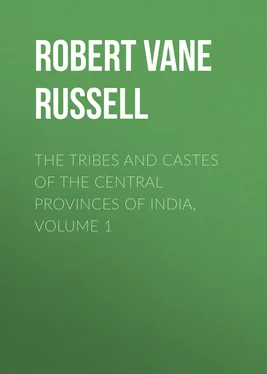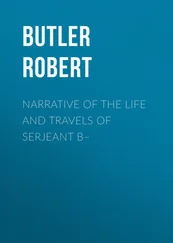Robert Vane Russell - The Tribes and Castes of the Central Provinces of India, Volume 1
Здесь есть возможность читать онлайн «Robert Vane Russell - The Tribes and Castes of the Central Provinces of India, Volume 1» — ознакомительный отрывок электронной книги совершенно бесплатно, а после прочтения отрывка купить полную версию. В некоторых случаях можно слушать аудио, скачать через торрент в формате fb2 и присутствует краткое содержание. Жанр: foreign_prose, История, foreign_edu, foreign_antique, на английском языке. Описание произведения, (предисловие) а так же отзывы посетителей доступны на портале библиотеки ЛибКат.
- Название:The Tribes and Castes of the Central Provinces of India, Volume 1
- Автор:
- Жанр:
- Год:неизвестен
- ISBN:нет данных
- Рейтинг книги:5 / 5. Голосов: 1
-
Избранное:Добавить в избранное
- Отзывы:
-
Ваша оценка:
- 100
- 1
- 2
- 3
- 4
- 5
The Tribes and Castes of the Central Provinces of India, Volume 1: краткое содержание, описание и аннотация
Предлагаем к чтению аннотацию, описание, краткое содержание или предисловие (зависит от того, что написал сам автор книги «The Tribes and Castes of the Central Provinces of India, Volume 1»). Если вы не нашли необходимую информацию о книге — напишите в комментариях, мы постараемся отыскать её.
The Tribes and Castes of the Central Provinces of India, Volume 1 — читать онлайн ознакомительный отрывок
Ниже представлен текст книги, разбитый по страницам. Система сохранения места последней прочитанной страницы, позволяет с удобством читать онлайн бесплатно книгу «The Tribes and Castes of the Central Provinces of India, Volume 1», без необходимости каждый раз заново искать на чём Вы остановились. Поставьте закладку, и сможете в любой момент перейти на страницу, на которой закончили чтение.
Интервал:
Закладка:
The Dhobi (washerman) and Kumhār (potter) are sometimes included among the impure castes, but, as already noted, their status is higher than that of the castes in this list.
Audhelia: Labouring caste of mixed descent who keep pigs.
Balāhi: Weavers and village messengers and watchmen.
Basor: Bamboo basket-makers and village musicians.
Chamār: Tanners and labourers.
Gānda: Weavers and village musicians.
Ghasia: Grass-cutters, labourers and sweepers.
Kaikāri: Vagrant basket-makers.
Kanjar, Beria, Sānsia: Gipsies and thieves.
Katia: Cotton-spinners.
Kori: Weavers and labourers.
Mādgi: Telugu tanners and hide-curriers.
Mahār: Weavers and labourers.
Māla: Telugu weavers and labourers.
Māng: Broom- and mat-makers and village musicians. They also castrate cattle.
Mehtar: Sweepers and scavengers.
Certain occupations, those of skinning cattle and curing hides, weaving the coarse country cloth worn by the villagers, making baskets from the rind of the bamboo, playing on drums and tom-toms, and scavenging generally are relegated to the lowest and impure castes. The hides of domestic animals are exceedingly impure; a Hindu is defiled even by touching their dead bodies and far more so by removing the skins. Drums and tom-toms made from the hides of animals are also impure. But in the case of weaving and basket-making the calling itself entails no defilement, and it would appear simply that they were despised by the cultivators, and as a considerable number of workers were required to satisfy the demand for baskets and cloth, were adopted by the servile and labouring castes. Basket- and mat-making are callings naturally suited to the primitive tribes who would obtain the bamboos from the forests, but weaving would not be associated with them unless cloth was first woven of tree-cotton. The weavers of the finer cotton and silk cloths, who live in towns, rank much higher than the village weavers, as in the case of the Koshtis and Tāntis, the latter of whom made the famous fine cotton cloth, known as abrawān , or ‘running water,’ which was supplied to the imperial Zenāna at Delhi. On one occasion a daughter of Aurāngzeb was reproached on entering the room for her immodest attire and excused herself by the plea that she had on seven folds of cloth over her body. 80 80 Sir H. Risley’s Tribes and Castes of Bengal , art. Tānti.
In Bengal Brāhmans will take water from Tāntis, and it seems clear that their higher status is a consequence of the lucrative and important nature of their occupation.
The Katias are a caste of cotton-spinners, the name being derived from kātna , to cut or spin. But hand-spinning is now practically an extinct industry and the Katias have taken to weaving or ordinary manual labour for a subsistence. The Kanjars and Berias are the gipsy castes of India. They are accustomed to wander about carrying their grass-matting huts with them. Many of them live by petty thieving and cheating. Their women practise palmistry and retail charms for the cure of sickness and for exorcising evil spirits, and love-philtres. They do cupping and tattooing and also make reed mats, cane baskets, palm-leaf mats and fans, ropes from grass- and tree-fibre, brushes for the cotton-loom, string-net purses and balls, and so on; and the women commonly dance and act as prostitutes. There is good reason for thinking that the Kanjars are the parents of the European gipsies, while the Thugs who formerly infested the high-roads of India, murdering solitary travellers and small parties by strangulation, may also have been largely derived from this caste. 81 81 See article Kanjar for a discussion of the connection of the gipsies and Thugs with the Kanjars.
41. Derivation of the impure castes from the indigenous tribes
It can only be definitely shown in a few instances that the existing impure occupational castes were directly derived from the indigenous tribes. The Chamār and Kori, and the Chuhra and Bhangi, or sweepers and scavengers of the Punjab and United Provinces, are now purely occupational castes and their original tribal affinities have entirely disappeared. The Chamārs and Mehtars or sweepers are in some places of a superior physical type, of comparatively good stature and light complexion; 82 82 See article Chamār, para. 1.
this may perhaps be due to a large admixture of Hindu blood through their women, during a social contact with the Hindus extending over many centuries, and also to the fact that they eat flesh when they can obtain it, including carrion. Such types are, however, exceptional among the impure castes, and there is no reason to doubt their general origin from the non-Aryan tribes, which in a few instances can be directly traced. Thus it seems likely that the Kanjars, Berias, Sānsias and other gipsy groups, as well as the Mirāsis, the vagrant bards and genealogists of the lower classes of Hindus, are derived from the Dom caste or tribe of Bengal, who are largely employed as sweepers and scavengers as well as on ordinary labour. The evidence for the origin of the above groups from the Doms is given in the article on Kanjar. Sir H.M. Elliot considered the Doms to be one of the original tribes of India. Again, there is no doubt that the impure Gānda caste, who are weavers, labourers and village musicians in the Uriya country and Chhattīsgarh Districts of the Central Provinces, are derived from the Pān tribe of Chota Nāgpur. The Pāns or Pābs are a regular forest tribe, and are sometimes called Gānda, while the Gāndas may be alternatively known as Pān. But the section of the tribe who live among the Hindus and are regarded as impure have now become a distinct caste with a separate name. The Bhuiya tribe were once the rulers of Chota Nāgpur; they still install the Rāja of Keonjhar, and have a traditional relation to other ruling families. But in parts of Chota Nāgpur and southern Bihār the Bhuiyas living in Hindu villages have become a separate impure caste with the opprobrious designation of Mūsahar or rat-eater. The great Mahār caste of the Marātha country or Bombay are weavers and labourers, and formerly cured hides, like the Chamārs and Koris of northern India. They are regarded as impure and were the serfs or villeins of the Kunbis, attached to the land. An alternative name for them is Dher, and this is supposed to be a corruption of Dharada a hillman, a name applied in Manu to all the indigenous races of India. Though the connection cannot be traced in all cases, there is thus no reason to doubt that the existing impure castes represent the subjected or enslaved section of the primitive non-Aryan tribes.
42. Occupation the basis of the caste system
It has been seen that the old Aryan polity comprised four classes: the Brāhmans and Kshatriyas or priestly and military aristocracy; the Vaishyas or body of the Aryans, who were ceremonially pure and could join in sacrifices; and the Sūdras or servile and impure class of labourers. The Vaishyas became cultivators and herdsmen, and their status of ceremonial purity was gradually transferred to the cultivating members of the village community, because land was the main source of wealth. Between the last two there arose another class of village menials and craftsmen, originating principally from the offspring of fathers of the Aryan classes and Sūdra women, to whom was left the practice of the village industries, despised by the cultivators. In spite of the almost complete fusion of races which the intercourse of centuries has effected, and the multiplication and rearrangement of castes produced by the diversity of occupation and other social factors, the divisions of the village community can still be recognised in the existing social gradation.
Читать дальшеИнтервал:
Закладка:
Похожие книги на «The Tribes and Castes of the Central Provinces of India, Volume 1»
Представляем Вашему вниманию похожие книги на «The Tribes and Castes of the Central Provinces of India, Volume 1» списком для выбора. Мы отобрали схожую по названию и смыслу литературу в надежде предоставить читателям больше вариантов отыскать новые, интересные, ещё непрочитанные произведения.
Обсуждение, отзывы о книге «The Tribes and Castes of the Central Provinces of India, Volume 1» и просто собственные мнения читателей. Оставьте ваши комментарии, напишите, что Вы думаете о произведении, его смысле или главных героях. Укажите что конкретно понравилось, а что нет, и почему Вы так считаете.












